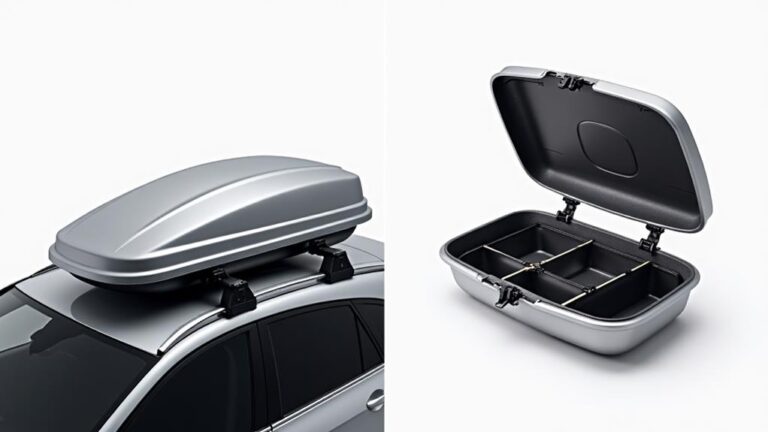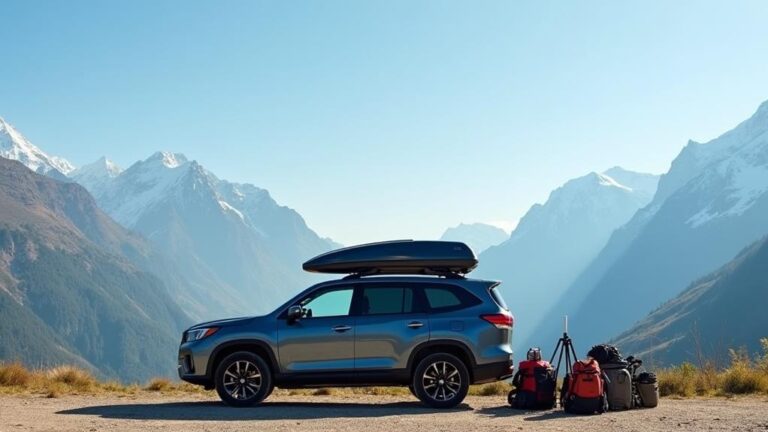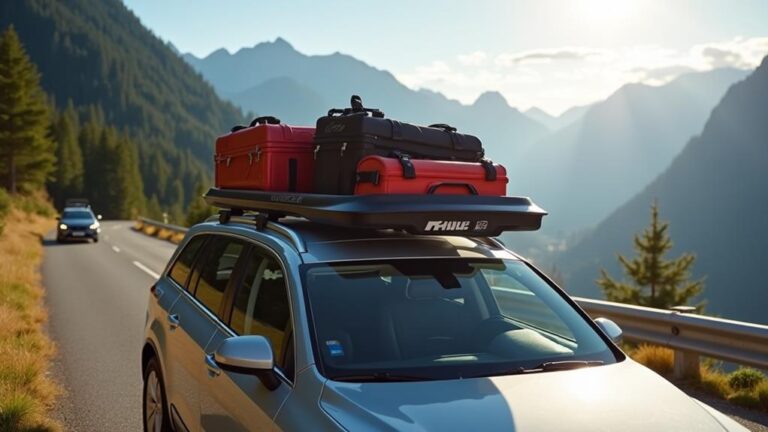You've finally decided to take your outdoor adventures to new heights with a rooftop tent. Before you can enjoy the thrill of camping under the stars, you'll need to get your tent securely attached to your car. It's not as simple as just placing it on top, as you'll need to consider factors like weight capacity, roof rack compatibility, and safety precautions. To ensure a successful installation, it's crucial to follow a step-by-step process. Start by preparing your vehicle for the added weight and stress – but that's just the beginning. What comes next?
Key Takeaways
- Ensure vehicle's cargo capacity and inspect for potential issues before adding a rooftop tent.
- Select the right mount type and material, considering weight capacity and compatibility with the vehicle.
- Follow manufacturer's instructions for lifting and handling the tent to avoid accidents or damage.
- Space mounts evenly apart for stability and attach the tent to the car's roof rack using clamps or straps.
- Conduct a final rooftop inspection to ensure all straps, clamps, and bolts are securely in place.
Prepare Your Vehicle
Before installing a rooftop tent on your car, ensure your vehicle is ready for the added weight and stress.
Conduct a thorough vehicle inspection to identify any potential issues that may affect its ability to support the tent. Check the condition of your car's roof, paying attention to any existing damage or rust that could compromise its structural integrity.
Verify your vehicle's cargo capacity to determine if it can handle the weight of the rooftop tent, occupants, and gear.
You'll find this information in your car's owner's manual or on the manufacturer's website. Be aware that the cargo capacity may vary depending on the type of vehicle and its configuration.
Additionally, consider upgrading your vehicle's suspension or installing reinforcement to support the added weight.
Ensure all roof racks, crossbars, and mounting systems are securely attached and rated for the weight of the tent. By doing so, you'll ensure a safe and reliable installation that can withstand various road conditions and weather.
Choose the Right Spot
When choosing the right spot for your rooftop tent on car, you'll need to consider several tent placement considerations, including weight distribution, roof accessibility, and the location of your vehicle's roof racks.
Assessing your available roof space is also crucial, as it will determine the maximum size of the rooftop tent you can install. To ensure a safe and secure setup, take precise measurements of your vehicle's roof to determine the optimal placement for your rooftop tent.
Tent Placement Considerations
Choosing the right spot for your rooftop tent is crucial to ensure a safe and enjoyable camping experience.
When deciding where to place your rooftop tent, consider the rooftop clearance of your vehicle. Ensure the tent is centered and positioned to maintain at least 2-3 inches of clearance between the tent's bottom and any roof features such as antennas, luggage racks, or sunroofs.
Another critical factor to consider is vehicle aerodynamics.
Proper placement of the rooftop tent can minimize wind noise and drag. Place the tent as far forward as possible while maintaining adequate clearance. This will reduce the impact of aerodynamic forces and help prevent the tent from being buffeted by strong winds.
Additionally, ensure the tent isn't obstructing any roof-mounted features such as side rails, crossbars, or roof racks.
Verify that the tent's weight is evenly distributed across the roof to avoid putting excessive stress on any particular point.
Proper placement of your rooftop tent is essential to ensure a safe and enjoyable camping experience.
Available Roof Space
Your car's roof offers a limited amount of space, and understanding its dimensions is crucial to finding the right spot for your rooftop tent.
Measure the length, width, and any obstructions on your roof to determine the available space. Check your car's manual or manufacturer's website for the roof capacity and recommended cargo weight to ensure the rooftop tent's weight doesn't exceed it.
Identify the roof's strong points, such as the roof rails or crossbars, which can support the weight of the tent.
Consider the location of the sunroof, antennas, or other features that may interfere with the tent's placement. Choose a spot that allows for easy access to the tent, taking into account the swing direction of the doors or liftgate.
Ensure the rooftop tent is centered and evenly distributed to maintain the car's balance and prevent any damage to the roof.
Verify the available space can accommodate the tent's folded dimensions, as well as its expanded size when set up. By carefully assessing your car's available roof space, you can choose the right spot for your rooftop tent and ensure a secure and comfortable camping experience.
Assemble the Tent
Typically, assembling a rooftop tent involves a straightforward process that requires attention to detail and moderate physical effort.
You'll need to unfold the tent and begin by attaching the tent frames to the base of the tent. Make sure to follow the manufacturer's instructions, as the frame design may vary depending on the model and brand of your rooftop tent.
Once the frames are securely attached, you can start to erect the tent's walls and roof.
Most rooftop tents come with folding mechanisms that allow for easy setup and takedown. You'll need to unfold these mechanisms and secure them in place using clips, straps, or other fastening systems.
As you assemble the tent, ensure all parts are securely attached and the structure is stable.
If your rooftop tent has additional features such as windows, doors, or a flysheet, follow the manufacturer's instructions to attach these components correctly.
Double-check all connections and make sure the tent is properly assembled before proceeding to the next step.
Install the Mounts
To install the mounts for your rooftop tent, you'll first need to select the right type of mount for your vehicle.
This involves considering the weight capacity and compatibility of different mount types with your car's make and model.
You'll also need to think about mount placement, taking into account factors such as roof rack location and the center of gravity of the tent.
Mount Type Selection
Selecting the right mount type is crucial for installing a rooftop tent on your car, as it directly impacts the tent's stability and the car's load capacity.
The mount type you choose will also affect the overall installation process and the security of your tent.
When choosing a mount type, consider the following factors:
1. Mount material: Decide on the material of the mounts, such as steel, aluminum, or a combination of both.
Steel mounts are generally stronger and more durable, while aluminum mounts are lighter and more corrosion-resistant.
2. Clamp style: Choose a clamp style that fits your car's roof type, such as a fixed clamp, a C-clamp, or a track-mounted clamp.
Ensure the clamp style is compatible with your car's roof thickness and material.
3. Load capacity: Verify the mount's load capacity to ensure it can support the weight of your rooftop tent and any additional gear.
Mount Placement Considerations
When installing a rooftop tent, the placement of the mounts is just as crucial as the mount type itself, as it directly affects the tent's stability and your car's load distribution.
You'll want to ensure that the mounts are positioned in a way that maximizes rooftop clearance, allowing for adequate space between the tent and the car's roof.
Consider the mounting system's weight capacity and the tent's size when determining the optimal placement.
Typically, you'll want to place the mounts near the car's roof rails or load bars, as these provide the necessary support and structural integrity.
Make sure the mounts are spaced evenly apart to maintain stability and prevent any twisting or flexing of the roof.
Consult your car's manual to determine the recommended mounting points and weight capacity.
You should also consider any specific requirements for your rooftop tent, such as the need for additional support or reinforcement.
Properly placed mounts are essential for a safe and secure rooftop tent installation.
Lift the Tent Safely
A rooftop tent's weight and bulk can make it difficult to handle, so it's essential you lift it safely to avoid injury or damage.
Proper lift techniques are crucial to maintain control and prevent accidents. When lifting a rooftop tent, consider its weight distribution to ensure even lifting and to prevent straining your back.
To lift the tent safely, follow these steps:
- Position yourself for optimal leverage: Stand close to the tent with your feet shoulder-width apart and your body centered over the tent.
- Use your leg muscles: Instead of relying on your back, use your leg muscles to lift the tent by bending your knees and straightening your legs.
- Maintain a secure grip: Hold the tent firmly with both hands, making sure your grip is secure and won't slip during the lifting process.
Secure the Tent Tight
Securing your rooftop tent tightly is crucial to ensure it remains in place during various weather conditions and driving scenarios.
Once you've lifted the tent onto your car, follow the manufacturer's instructions for securing it. Typically, this involves attaching the tent to your car's roof rack using clamps or straps.
Make sure to tighten all straps and clamps firmly, but avoid over-tightening, which can damage the tent or your car's roof.
Use the tightening systems provided with your tent to ensure a secure fit. These systems usually include ratcheting straps or knobs that allow you to adjust the tension.
Additionally, consider using tent weights to add extra stability to the tent, especially in windy conditions.
These weights can be attached to the tent's legs or straps to keep it firmly in place. When securing the tent, double-check that all straps and clamps are properly attached and tightened to prevent any shifting or movement during use.
Final Safety Check
Before using your rooftop tent, it's essential to conduct a final safety check to ensure you've properly secured it to your car.
It's crucial to verify that all connections are tight and the tent is stable to avoid any accidents or damage.
1. Verify Ladder and Stair Security: Ensure that the ladder or stairs leading up to the tent are securely attached to the car and the tent. Make sure they're stable and can hold your weight.
2. Rooftop Inspection: Conduct a final rooftop inspection to ensure that all straps, clamps, and bolts are securely in place.
Check for any signs of wear or damage that could compromise the tent's stability.
3. Final Verification of Weights and Load: Double-check that the weight and load of the tent and its occupants are within the car's and tent's specified limits.
This final verification will help prevent any structural damage or instability.
Frequently Asked Questions
Can I Install a Rooftop Tent on Any Car Model?
You'll need to check the vehicle compatibility of your car before installing a rooftop tent, as some models have car restrictions, such as weight limits or roof structure limitations, that may affect installation.
How Much Weight Can a Rooftop Tent Typically Hold?
Imagine your rooftop tent as a cozy nest, but don't overfill it. Typically, rooftop tents can hold 2-6 people, with weight capacities ranging from 400-1,200 pounds. Consider tent capacity limits and weight distribution concerns to ensure safety.
Can I Use a Rooftop Tent in Extreme Weather Conditions?
You can use a rooftop tent in extreme weather conditions, but it's crucial to check the manufacturer's ratings for winter camping and extreme winds, as some models are designed to withstand these conditions better than others.
Are Rooftop Tents Suitable for Long-Term Camping Use?
Like a home away from home, rooftop tents provide camping comfort for off-grid adventures. You'll find they're suitable for long-term camping use, offering durable materials, waterproof designs, and ample interior space to make your extended stays cozy.
Can I Install a Rooftop Tent by Myself or Is Help Required?
When handling rooftop tents, you'll encounter solo struggles and tent tensions, making installation tricky. Consider enlisting help to alleviate potential risks and ensure a secure, even setup, especially for larger or heavier models.
Conclusion
Now that you've completed the 7 steps, you're ready to enjoy the benefits of rooftop tent camping. Interestingly, it's estimated that over 1.3 million people in the US alone participate in car camping each year. Remember to always follow the manufacturer's instructions and take necessary safety precautions when handling heavy equipment. Your rooftop tent is now securely in place, allowing you to explore the great outdoors with ease and convenience.












